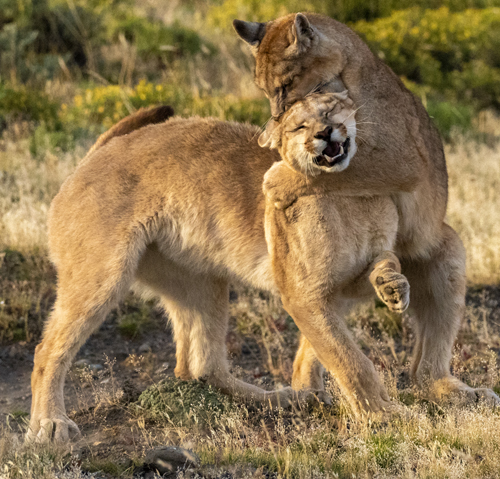
Pumas and Wildlife of Chile 2020 Trip 1
We've been traveling to southern Chile's Torres del Paine National Park for over twenty years, and for the last ten or so our trips have been focused on Pumas. I can honestly say we were the first photo tour leaders to bring photographers to this area for Puma photography, and during that time we've seen many changes.
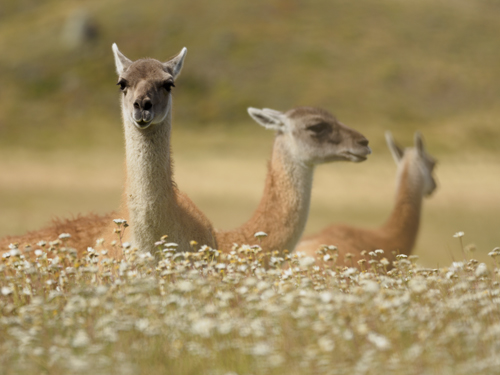
One of the biggest was the change in the Park. When we first started, photographers could wander virtually anywhere, and the lack of people and the freedom of no restrictions made this Park one of our all-time favorites. As Pumas became more habituated and visible, and as other groups began to visit the area, Park authorities worried that someone might be injured by a Puma, and the Park instituted a new policy - no off-trail hiking! We feared that this might end great Puma viewing, but that wasn't the case, as private land near by became an even better location for the Pumas.
One trail did remain open, until this year. The trail ran along the fenceline that separated the Park from the private land, and the fence was a death-trap for baby Guanacos. Pumas frequently the area, and we had had many great shooting opportunities there. Some time during 2019 a young tourist had an encounter with a young Puma, which jumped on him (so the story goes), and although the tourist wasn't injured, the Park closed the trail to all but Ranger-escorted hikers.
Nonetheless, over the years the Puma photography has only grown better and better, and today it's not difficult to see well over 10 pumas in a 5 day trip. On our first Photo Tour this year we had 31 sightings! These were not 31 different Pumas, but repeated sightings of perhaps as many as 9 different cats in our morning and afternoon excursions.
The shooting was incredible, and here's the details of our day-to-day adventure.
Day 1
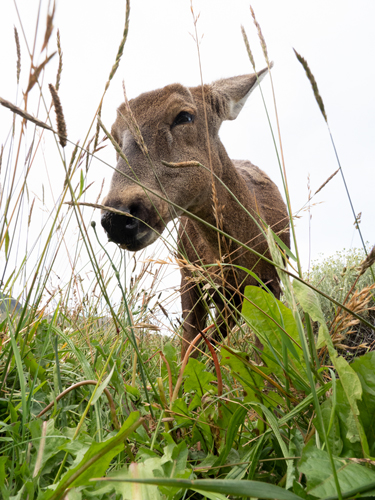 40 minutes after leaving the lodge we had our first Puma. A female who was obviously in heat, and her vocalizations were responsible for our guide spotting her. A large male was in attendance, but remarkably, despite her slinky in-heat behavior, weaving around his head and neck and presenting herself repeatedly, he was uninterested. Eventually they moved downhill and then away from us, with the male following behind but seemingly with no interest in mating.
40 minutes after leaving the lodge we had our first Puma. A female who was obviously in heat, and her vocalizations were responsible for our guide spotting her. A large male was in attendance, but remarkably, despite her slinky in-heat behavior, weaving around his head and neck and presenting herself repeatedly, he was uninterested. Eventually they moved downhill and then away from us, with the male following behind but seemingly with no interest in mating.
The distance was far, and except for the longest lenses nothing more than an incredible observation, although for the folks who had never seen a Puma before, they were disappointed in the viewing. Mary and I were not, knowing how hard it can be to see any Puma, and with the experience of spending nearly ten years with searching, often going an entire trip with no more evidence of a cat than a fresh kill.
We had another Puma too, a female that is extremely tolerant that materialized in the high grass next to a girl who was off the road and photographing birds. She was close to the cat, and neither one was concerned with the other. We didn’t have a permit to be off-road, so we had to watch, a bit frustrated, since we didn’t want to jeopardize the off-road permits we’d have over the next several days.
3 Pumas
Day 2
We started in the pre-dawn, and soon had a Puma silhouetted against an orange sky. We had a permit and started following the cat, one of five in a family group of 4 nearly full-grown cubs and a tolerant mother. We had some wonderful back-lighted views of the family as they headed down towards a lake, often quite close, before they disappeared into black brush.
We left them then, but a BBC cameraman stayed behind, and later filmed an encounter between this mother and another Puma, Blinka, who was thought to have cubs. Blinka won the short fight, probably because she was defending two cubs hidden in the brush. The cameraman later filmed Blinka as she moved the cubs to a new hideout, a small cave near the lake.
Our tracker found another Puma, high on a ridge, but we were able to drive cross-country on a defined track to get within an easy walking distances. We had some closeups before she moved off, apparently intent on a Guanaco herd. Unfortunately they spotted her and any chance of a hunt was over.
Six Pumas
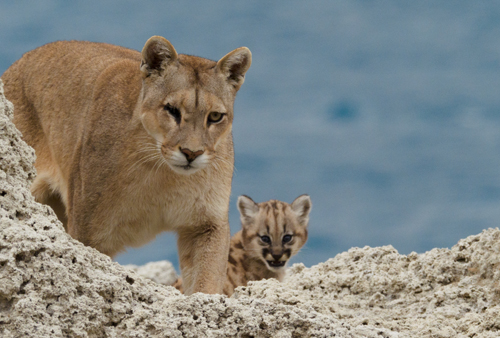
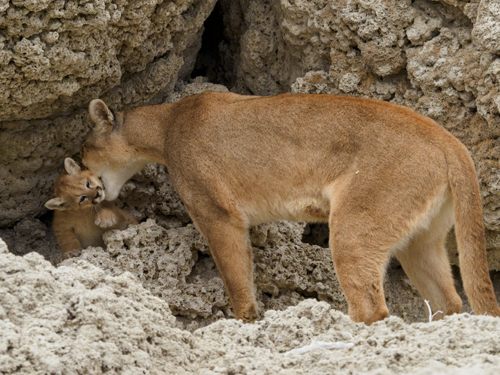
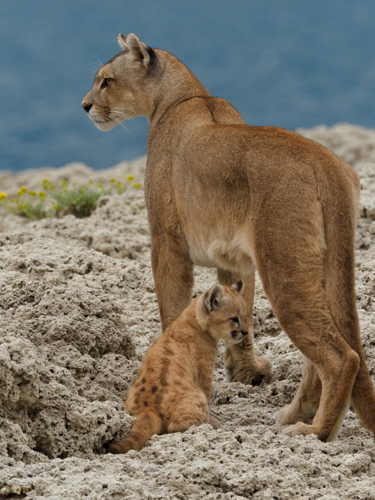
PM. Our tracker found Blinka’s den, a small cave near the lake. When we arrived the surprisingly bold cubs were peering from the cave entrance. The cubs were perhaps 7 weeks old, the smallest we’ve ever seen. Blinka was nearby, resting, but eventually joined the cubs, picking one up in her jaws, and carrying it a short distance. Cubs and mother posed on a rock overlooking the lake, making for great shots. Eventually she moved the cubs to the opposite side of the rock, and wishing to leave her with a benign encounter, we left her then.
3 Pumas
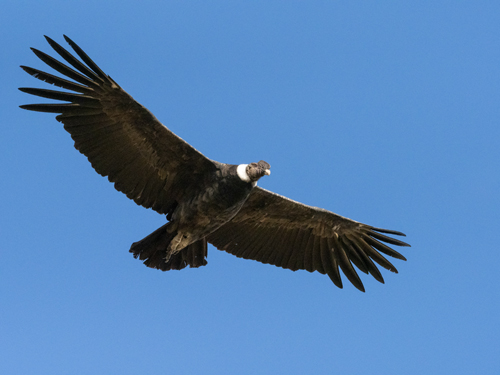
Day 3
We returned to the den area, where once again our tracker located their new location. Blinka posed wonderfully on a rock against a gray sky, then checked on the cubs before heading uphill to hunt. We stayed for several hours, hoping she’d return, rewarded with one brief glimpse as a cub darted across a small opening.
Other trackers radioed us that Blinka was now far uphill, hunting, and unlikely to return while we waited. We continued on, stopping for shots of the Towers and some flowers. As we were about to pack up and leave, Mary spotted a Patagonian Gray Fox approaching. The cat must have been fed by a road crew, because it was unafraid and circled quite close to us before settling amongst some flowers where we photographed her until we were shot out.
2 Pumas
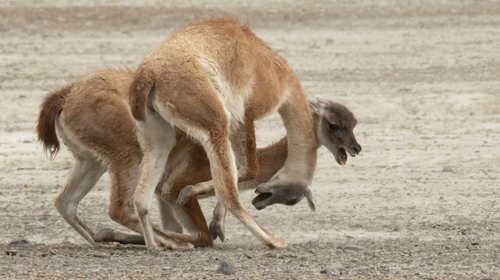
PM. We headed back to Blinka’s den, hoping to photograph her as she reunited with her cubs. She had been heading our way when she caught a European Hare, which she fed upon, and then made an attempt at a hunt of a Guanaco. A storm was coming our way, so we decided to avoid the storm and head to the road where, we hoped, Blinka would cross.
We were too late when she reached a roadside pond where she drank, but we did get good shots as she walked passed us, and then headed down the center line of the road, up a hill, and crossing by us once again.
We were half-way to home when we heard of another cat, Amber, who was near the Park boundary. We turned around and headed back, and caught her still sleeping on a small rise. As we headed back to the cars, calling it a day, Amber rose and walked towards us, crossed beneath the Park boundary fence, and eventually headed up the center line of the Park road, our last view of her in the growing gloom.
2 Pumas
Day 4
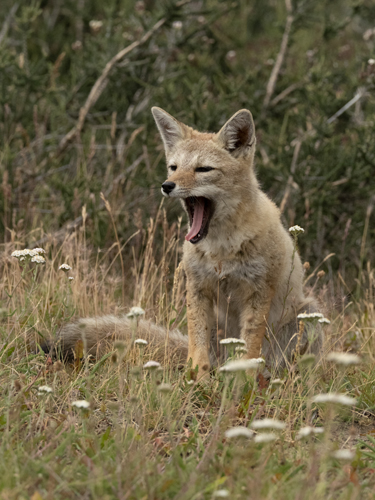 It rained overnight and a cold front brought chill and dampness. We spent a part of the morning waiting for one of the trackers to spot a cat, but no one, all morning, was successful.
It rained overnight and a cold front brought chill and dampness. We spent a part of the morning waiting for one of the trackers to spot a cat, but no one, all morning, was successful.
Mid-morning we headed towards Lago Azul where we hoped to photograph the Towers, and the Lupine flower fields nearby. At the lake we had our best, ever, Chilean Flamingos, a pair that were quite tolerant and provided near frame-filling shots – all with everyone on the established hiking trail that ran parallel to the park road. Chloe Wigeons, Coots, and other water birds rounded out that shoot.
We also shot Lupines and an incredible field of Daisy Flowers, and at the end of the morning the waterfall. For once, we arrived back at the lodge at noon – a record early arrival.
PM. During our afternoon break it rained, hailed, and blew, and our prospects for the afternoon seemed bleak. We headed out in a light rain, but at one of the Park overlooks we were treated to a grand landscape of the towers. Later, another cat, Princessa, was spotted, and we headed to her.
We found Princessa in black brush, but after an hour’s wait she rose, and began a walk towards the Park road. We raced back to the cars in the hopes of encountering her as she crossed, but she stopped somewhere en route and no other opportunities arose.
1 Puma
Day 5
Like our very first afternoon, today we did not have an off-road permit. That was fortunate. The day started clear, cold, and very windy, and none of the Puma trackers or scouts located a Puma today. We started late, with a 7:45AM departure, which gave everyone a much needed rest and a hearty breakfast before a full day afield.
Not having a permit, we headed in to the Park for a full day of photography, filling in subjects we’ve missed in our quest for Pumas. We started right at our lodge, looking for Austral Pigmy Owls. Although unsuccessful here, we had great Elanas, Chilean Flickers, Siskins, Austral Parakeets, Ducans, and Caracaras while we searched for the owls.
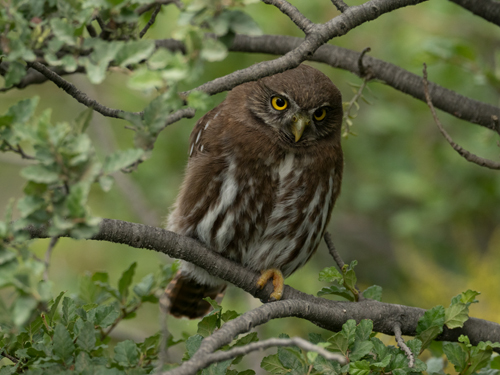
Continuing on, we stopped at a low scrub beech forest where we found two immature Pigmy Owls, right by the road. The two birds flew from one nearby tree to another, often giving us near frame-filling shots.
Entering the park, we worked on scenic as the mountain periodically revealed itself from a veil of clouds, snow squalls, and rain, which we did throughout the rest of the day. The remainder of the day was mostly scenic, with the exception of two encounters with Andean Condors flying low enough for good shots.
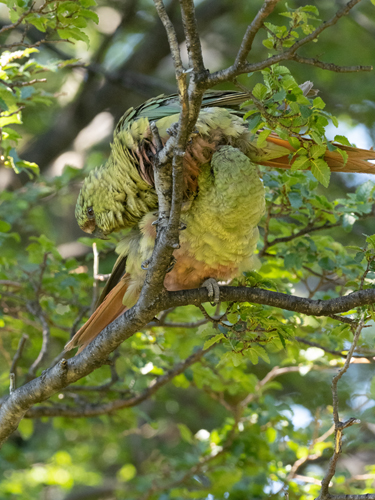
We returned to the lodge around 6PM, a record, but before dinner our guide showed us a sequence from One Earth/Seven Worlds, featuring the most spectacular Puma hunting sequences I’ve ever seen. After seeing how a Puma, attempting to take down an animal 3 or 4 times its weight, and being beat up and flipped, I don’t think there is a tougher or more agile predator than the Puma. Next, our guide showed us his film on a conservation project – 4 minutes that was stunning, truly professional, and we were quite impressed.
Day 6
Our last day and our last permit. One of our scouts located the mother Puma with her 4 nearly full grown cubs, high up in the plateau. Fortunately, we could drive there, where we found the five in the last stages of finishing up a baby Guanaco kill.
We had some good shooting of the cats walking about, playing, and chasing one another, before the mother started wandering off. Her cubs were high above her in the rocks, and since they were not following she returned to the kill. Then, she started out again, with the cubs in tow.
Before our guide, or a professional BBC cameraman could react to this, Mary said ‘They’re going to the water! What do cats always do after eating!’ We headed downhill, not following the cats, and arrived at a small mountain lake just minutes after the cats, first (our group, that is), and had all five cats drinking in a nearly mirror-still lake, as the sun crested a slope and bathed them in golden light. Afterwards, the cats paralleled the shoreline, and walked right by us – about 15 feet from me – as they headed up hill.
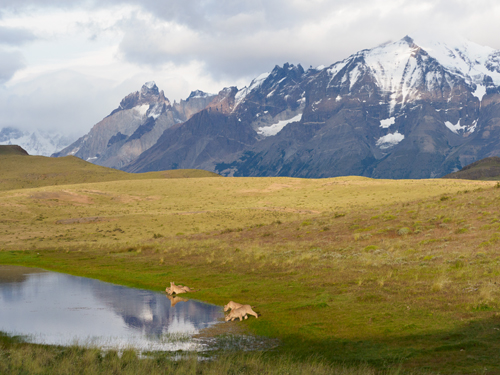
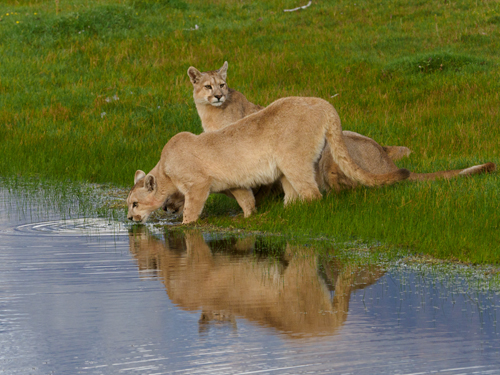
We followed, and from that vantage they watched a lone, baby guanaco which, lucky for it, decided to run down hill and out of their kill zone.
We had another radio call that Blinka had been seen, and we headed there, encountering her just as she and her two cubs took shelter in black bush for the day. We returned to the 5 Pumas, but they were settled down, and we spent the rest of the morning photographing Guanacos in the lowlands.
8 Pumas – family of 5, and family of 3
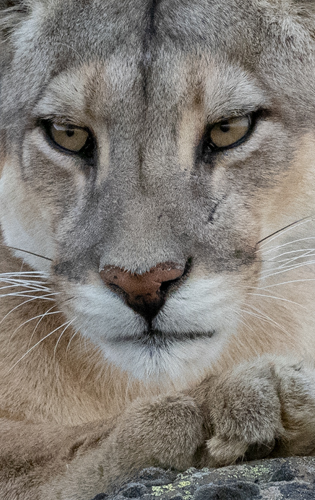 PM. Our last shoot and we headed back to the Puma family, Rupestre the female, and her four cubs. The walk this evening was fairly easy, up one steep hill and across the conglomerate rocks, although Mary was almost blown over by a hard wind.
PM. Our last shoot and we headed back to the Puma family, Rupestre the female, and her four cubs. The walk this evening was fairly easy, up one steep hill and across the conglomerate rocks, although Mary was almost blown over by a hard wind.
When we arrived at their resting spot one cub was perched atop a rock. Soon we spotted the four other cubs, who were lying in the grass or at the entrance of a cave-like depression. Although the cub dropped from the rock, later all four cubs climbed atop another rock, with three of the four facing us as they lounged about.
There was a kill, supposedly from another Puma that was shy and departed – or so we heard, closeby and within sight of the cubs. Rupestre wasn’t visible, and we hoped that she’d show, and lead the cubs to this easy meal, but it didn’t happen.
At 9:15 we headed to the vehicles, with our guide and I walking the ridge to reach the car. Along the way I found the female, on the route I was taking, but I saw her far enough off that I could divert, and not disturb her sleep.
As we headed home a tourist bus was stopped, and they signaled that they had a Puma in view. We saw it, at a distance, but that made our 31st sighting for the trip.
6 Pumas
Join us on Facebook at: Follow Hoot Hollow
Office Phone: (717) 543-6423
Or FAX us at: (717) 543-5342
Mary and Joe are proud to endorse the Photo Retailer that has
done the absolute most in supporting nature photography in all
its facets ---

Check out the Monthly Specials
from Hunt's
test

Pumas and Wildlife of Chile 2020 Trip 1
We've been traveling to southern Chile's Torres del Paine National Park for over twenty years, and for the last ten or so our trips have been focused on Pumas. I can honestly say we were the first photo tour leaders to bring photographers to this area for Puma photography, and during that time we've seen many changes.

One of the biggest was the change in the Park. When we first started, photographers could wander virtually anywhere, and the lack of people and the freedom of no restrictions made this Park one of our all-time favorites. As Pumas became more habituated and visible, and as other groups began to visit the area, Park authorities worried that someone might be injured by a Puma, and the Park instituted a new policy - no off-trail hiking! We feared that this might end great Puma viewing, but that wasn't the case, as private land near by became an even better location for the Pumas.
One trail did remain open, until this year. The trail ran along the fenceline that separated the Park from the private land, and the fence was a death-trap for baby Guanacos. Pumas frequently the area, and we had had many great shooting opportunities there. Some time during 2019 a young tourist had an encounter with a young Puma, which jumped on him (so the story goes), and although the tourist wasn't injured, the Park closed the trail to all but Ranger-escorted hikers.
Nonetheless, over the years the Puma photography has only grown better and better, and today it's not difficult to see well over 10 pumas in a 5 day trip. On our first Photo Tour this year we had 31 sightings! These were not 31 different Pumas, but repeated sightings of perhaps as many as 9 different cats in our morning and afternoon excursions.
The shooting was incredible, and here's the details of our day-to-day adventure.
Day 1
 40 minutes after leaving the lodge we had our first Puma. A female who was obviously in heat, and her vocalizations were responsible for our guide spotting her. A large male was in attendance, but remarkably, despite her slinky in-heat behavior, weaving around his head and neck and presenting herself repeatedly, he was uninterested. Eventually they moved downhill and then away from us, with the male following behind but seemingly with no interest in mating.
40 minutes after leaving the lodge we had our first Puma. A female who was obviously in heat, and her vocalizations were responsible for our guide spotting her. A large male was in attendance, but remarkably, despite her slinky in-heat behavior, weaving around his head and neck and presenting herself repeatedly, he was uninterested. Eventually they moved downhill and then away from us, with the male following behind but seemingly with no interest in mating.
The distance was far, and except for the longest lenses nothing more than an incredible observation, although for the folks who had never seen a Puma before, they were disappointed in the viewing. Mary and I were not, knowing how hard it can be to see any Puma, and with the experience of spending nearly ten years with searching, often going an entire trip with no more evidence of a cat than a fresh kill.
We had another Puma too, a female that is extremely tolerant that materialized in the high grass next to a girl who was off the road and photographing birds. She was close to the cat, and neither one was concerned with the other. We didn’t have a permit to be off-road, so we had to watch, a bit frustrated, since we didn’t want to jeopardize the off-road permits we’d have over the next several days.
3 Pumas
Day 2
We started in the pre-dawn, and soon had a Puma silhouetted against an orange sky. We had a permit and started following the cat, one of five in a family group of 4 nearly full-grown cubs and a tolerant mother. We had some wonderful back-lighted views of the family as they headed down towards a lake, often quite close, before they disappeared into black brush.
We left them then, but a BBC cameraman stayed behind, and later filmed an encounter between this mother and another Puma, Blinka, who was thought to have cubs. Blinka won the short fight, probably because she was defending two cubs hidden in the brush. The cameraman later filmed Blinka as she moved the cubs to a new hideout, a small cave near the lake.
Our tracker found another Puma, high on a ridge, but we were able to drive cross-country on a defined track to get within an easy walking distances. We had some closeups before she moved off, apparently intent on a Guanaco herd. Unfortunately they spotted her and any chance of a hunt was over.
Six Pumas



PM. Our tracker found Blinka’s den, a small cave near the lake. When we arrived the surprisingly bold cubs were peering from the cave entrance. The cubs were perhaps 7 weeks old, the smallest we’ve ever seen. Blinka was nearby, resting, but eventually joined the cubs, picking one up in her jaws, and carrying it a short distance. Cubs and mother posed on a rock overlooking the lake, making for great shots. Eventually she moved the cubs to the opposite side of the rock, and wishing to leave her with a benign encounter, we left her then.
3 Pumas

Day 3
We returned to the den area, where once again our tracker located their new location. Blinka posed wonderfully on a rock against a gray sky, then checked on the cubs before heading uphill to hunt. We stayed for several hours, hoping she’d return, rewarded with one brief glimpse as a cub darted across a small opening.
Other trackers radioed us that Blinka was now far uphill, hunting, and unlikely to return while we waited. We continued on, stopping for shots of the Towers and some flowers. As we were about to pack up and leave, Mary spotted a Patagonian Gray Fox approaching. The cat must have been fed by a road crew, because it was unafraid and circled quite close to us before settling amongst some flowers where we photographed her until we were shot out.
2 Pumas

PM. We headed back to Blinka’s den, hoping to photograph her as she reunited with her cubs. She had been heading our way when she caught a European Hare, which she fed upon, and then made an attempt at a hunt of a Guanaco. A storm was coming our way, so we decided to avoid the storm and head to the road where, we hoped, Blinka would cross.
We were too late when she reached a roadside pond where she drank, but we did get good shots as she walked passed us, and then headed down the center line of the road, up a hill, and crossing by us once again.
We were half-way to home when we heard of another cat, Amber, who was near the Park boundary. We turned around and headed back, and caught her still sleeping on a small rise. As we headed back to the cars, calling it a day, Amber rose and walked towards us, crossed beneath the Park boundary fence, and eventually headed up the center line of the Park road, our last view of her in the growing gloom.
2 Pumas
Day 4
 It rained overnight and a cold front brought chill and dampness. We spent a part of the morning waiting for one of the trackers to spot a cat, but no one, all morning, was successful.
It rained overnight and a cold front brought chill and dampness. We spent a part of the morning waiting for one of the trackers to spot a cat, but no one, all morning, was successful.
Mid-morning we headed towards Lago Azul where we hoped to photograph the Towers, and the Lupine flower fields nearby. At the lake we had our best, ever, Chilean Flamingos, a pair that were quite tolerant and provided near frame-filling shots – all with everyone on the established hiking trail that ran parallel to the park road. Chloe Wigeons, Coots, and other water birds rounded out that shoot.
We also shot Lupines and an incredible field of Daisy Flowers, and at the end of the morning the waterfall. For once, we arrived back at the lodge at noon – a record early arrival.
PM. During our afternoon break it rained, hailed, and blew, and our prospects for the afternoon seemed bleak. We headed out in a light rain, but at one of the Park overlooks we were treated to a grand landscape of the towers. Later, another cat, Princessa, was spotted, and we headed to her.
We found Princessa in black brush, but after an hour’s wait she rose, and began a walk towards the Park road. We raced back to the cars in the hopes of encountering her as she crossed, but she stopped somewhere en route and no other opportunities arose.
1 Puma
Day 5
Like our very first afternoon, today we did not have an off-road permit. That was fortunate. The day started clear, cold, and very windy, and none of the Puma trackers or scouts located a Puma today. We started late, with a 7:45AM departure, which gave everyone a much needed rest and a hearty breakfast before a full day afield.
Not having a permit, we headed in to the Park for a full day of photography, filling in subjects we’ve missed in our quest for Pumas. We started right at our lodge, looking for Austral Pigmy Owls. Although unsuccessful here, we had great Elanas, Chilean Flickers, Siskins, Austral Parakeets, Ducans, and Caracaras while we searched for the owls.

Continuing on, we stopped at a low scrub beech forest where we found two immature Pigmy Owls, right by the road. The two birds flew from one nearby tree to another, often giving us near frame-filling shots.
Entering the park, we worked on scenic as the mountain periodically revealed itself from a veil of clouds, snow squalls, and rain, which we did throughout the rest of the day. The remainder of the day was mostly scenic, with the exception of two encounters with Andean Condors flying low enough for good shots.

We returned to the lodge around 6PM, a record, but before dinner our guide showed us a sequence from One Earth/Seven Worlds, featuring the most spectacular Puma hunting sequences I’ve ever seen. After seeing how a Puma, attempting to take down an animal 3 or 4 times its weight, and being beat up and flipped, I don’t think there is a tougher or more agile predator than the Puma. Next, our guide showed us his film on a conservation project – 4 minutes that was stunning, truly professional, and we were quite impressed.
Day 6
Our last day and our last permit. One of our scouts located the mother Puma with her 4 nearly full grown cubs, high up in the plateau. Fortunately, we could drive there, where we found the five in the last stages of finishing up a baby Guanaco kill.
We had some good shooting of the cats walking about, playing, and chasing one another, before the mother started wandering off. Her cubs were high above her in the rocks, and since they were not following she returned to the kill. Then, she started out again, with the cubs in tow.
Before our guide, or a professional BBC cameraman could react to this, Mary said ‘They’re going to the water! What do cats always do after eating!’ We headed downhill, not following the cats, and arrived at a small mountain lake just minutes after the cats, first (our group, that is), and had all five cats drinking in a nearly mirror-still lake, as the sun crested a slope and bathed them in golden light. Afterwards, the cats paralleled the shoreline, and walked right by us – about 15 feet from me – as they headed up hill.


We followed, and from that vantage they watched a lone, baby guanaco which, lucky for it, decided to run down hill and out of their kill zone.
We had another radio call that Blinka had been seen, and we headed there, encountering her just as she and her two cubs took shelter in black bush for the day. We returned to the 5 Pumas, but they were settled down, and we spent the rest of the morning photographing Guanacos in the lowlands.
8 Pumas – family of 5, and family of 3
 PM. Our last shoot and we headed back to the Puma family, Rupestre the female, and her four cubs. The walk this evening was fairly easy, up one steep hill and across the conglomerate rocks, although Mary was almost blown over by a hard wind.
PM. Our last shoot and we headed back to the Puma family, Rupestre the female, and her four cubs. The walk this evening was fairly easy, up one steep hill and across the conglomerate rocks, although Mary was almost blown over by a hard wind.
When we arrived at their resting spot one cub was perched atop a rock. Soon we spotted the four other cubs, who were lying in the grass or at the entrance of a cave-like depression. Although the cub dropped from the rock, later all four cubs climbed atop another rock, with three of the four facing us as they lounged about.
There was a kill, supposedly from another Puma that was shy and departed – or so we heard, closeby and within sight of the cubs. Rupestre wasn’t visible, and we hoped that she’d show, and lead the cubs to this easy meal, but it didn’t happen.
At 9:15 we headed to the vehicles, with our guide and I walking the ridge to reach the car. Along the way I found the female, on the route I was taking, but I saw her far enough off that I could divert, and not disturb her sleep.
As we headed home a tourist bus was stopped, and they signaled that they had a Puma in view. We saw it, at a distance, but that made our 31st sighting for the trip.
6 Pumas
Join us on Facebook at: Follow Hoot Hollow
Office Phone: (717) 543-6423
Or FAX us at: (717) 543-5342
Mary and Joe are proud to endorse the Photo Retailer that has
done the absolute most in supporting nature photography in all
its facets ---

Check out the Monthly Specials
from Hunt's
test

Pumas and Wildlife of Chile 2020 Trip 1
We've been traveling to southern Chile's Torres del Paine National Park for over twenty years, and for the last ten or so our trips have been focused on Pumas. I can honestly say we were the first photo tour leaders to bring photographers to this area for Puma photography, and during that time we've seen many changes.

One of the biggest was the change in the Park. When we first started, photographers could wander virtually anywhere, and the lack of people and the freedom of no restrictions made this Park one of our all-time favorites. As Pumas became more habituated and visible, and as other groups began to visit the area, Park authorities worried that someone might be injured by a Puma, and the Park instituted a new policy - no off-trail hiking! We feared that this might end great Puma viewing, but that wasn't the case, as private land near by became an even better location for the Pumas.
One trail did remain open, until this year. The trail ran along the fenceline that separated the Park from the private land, and the fence was a death-trap for baby Guanacos. Pumas frequently the area, and we had had many great shooting opportunities there. Some time during 2019 a young tourist had an encounter with a young Puma, which jumped on him (so the story goes), and although the tourist wasn't injured, the Park closed the trail to all but Ranger-escorted hikers.
Nonetheless, over the years the Puma photography has only grown better and better, and today it's not difficult to see well over 10 pumas in a 5 day trip. On our first Photo Tour this year we had 31 sightings! These were not 31 different Pumas, but repeated sightings of perhaps as many as 9 different cats in our morning and afternoon excursions.
The shooting was incredible, and here's the details of our day-to-day adventure.
Day 1
 40 minutes after leaving the lodge we had our first Puma. A female who was obviously in heat, and her vocalizations were responsible for our guide spotting her. A large male was in attendance, but remarkably, despite her slinky in-heat behavior, weaving around his head and neck and presenting herself repeatedly, he was uninterested. Eventually they moved downhill and then away from us, with the male following behind but seemingly with no interest in mating.
40 minutes after leaving the lodge we had our first Puma. A female who was obviously in heat, and her vocalizations were responsible for our guide spotting her. A large male was in attendance, but remarkably, despite her slinky in-heat behavior, weaving around his head and neck and presenting herself repeatedly, he was uninterested. Eventually they moved downhill and then away from us, with the male following behind but seemingly with no interest in mating.
The distance was far, and except for the longest lenses nothing more than an incredible observation, although for the folks who had never seen a Puma before, they were disappointed in the viewing. Mary and I were not, knowing how hard it can be to see any Puma, and with the experience of spending nearly ten years with searching, often going an entire trip with no more evidence of a cat than a fresh kill.
We had another Puma too, a female that is extremely tolerant that materialized in the high grass next to a girl who was off the road and photographing birds. She was close to the cat, and neither one was concerned with the other. We didn’t have a permit to be off-road, so we had to watch, a bit frustrated, since we didn’t want to jeopardize the off-road permits we’d have over the next several days.
3 Pumas
Day 2
We started in the pre-dawn, and soon had a Puma silhouetted against an orange sky. We had a permit and started following the cat, one of five in a family group of 4 nearly full-grown cubs and a tolerant mother. We had some wonderful back-lighted views of the family as they headed down towards a lake, often quite close, before they disappeared into black brush.
We left them then, but a BBC cameraman stayed behind, and later filmed an encounter between this mother and another Puma, Blinka, who was thought to have cubs. Blinka won the short fight, probably because she was defending two cubs hidden in the brush. The cameraman later filmed Blinka as she moved the cubs to a new hideout, a small cave near the lake.
Our tracker found another Puma, high on a ridge, but we were able to drive cross-country on a defined track to get within an easy walking distances. We had some closeups before she moved off, apparently intent on a Guanaco herd. Unfortunately they spotted her and any chance of a hunt was over.
Six Pumas



PM. Our tracker found Blinka’s den, a small cave near the lake. When we arrived the surprisingly bold cubs were peering from the cave entrance. The cubs were perhaps 7 weeks old, the smallest we’ve ever seen. Blinka was nearby, resting, but eventually joined the cubs, picking one up in her jaws, and carrying it a short distance. Cubs and mother posed on a rock overlooking the lake, making for great shots. Eventually she moved the cubs to the opposite side of the rock, and wishing to leave her with a benign encounter, we left her then.
3 Pumas

Day 3
We returned to the den area, where once again our tracker located their new location. Blinka posed wonderfully on a rock against a gray sky, then checked on the cubs before heading uphill to hunt. We stayed for several hours, hoping she’d return, rewarded with one brief glimpse as a cub darted across a small opening.
Other trackers radioed us that Blinka was now far uphill, hunting, and unlikely to return while we waited. We continued on, stopping for shots of the Towers and some flowers. As we were about to pack up and leave, Mary spotted a Patagonian Gray Fox approaching. The cat must have been fed by a road crew, because it was unafraid and circled quite close to us before settling amongst some flowers where we photographed her until we were shot out.
2 Pumas

PM. We headed back to Blinka’s den, hoping to photograph her as she reunited with her cubs. She had been heading our way when she caught a European Hare, which she fed upon, and then made an attempt at a hunt of a Guanaco. A storm was coming our way, so we decided to avoid the storm and head to the road where, we hoped, Blinka would cross.
We were too late when she reached a roadside pond where she drank, but we did get good shots as she walked passed us, and then headed down the center line of the road, up a hill, and crossing by us once again.
We were half-way to home when we heard of another cat, Amber, who was near the Park boundary. We turned around and headed back, and caught her still sleeping on a small rise. As we headed back to the cars, calling it a day, Amber rose and walked towards us, crossed beneath the Park boundary fence, and eventually headed up the center line of the Park road, our last view of her in the growing gloom.
2 Pumas
Day 4
 It rained overnight and a cold front brought chill and dampness. We spent a part of the morning waiting for one of the trackers to spot a cat, but no one, all morning, was successful.
It rained overnight and a cold front brought chill and dampness. We spent a part of the morning waiting for one of the trackers to spot a cat, but no one, all morning, was successful.
Mid-morning we headed towards Lago Azul where we hoped to photograph the Towers, and the Lupine flower fields nearby. At the lake we had our best, ever, Chilean Flamingos, a pair that were quite tolerant and provided near frame-filling shots – all with everyone on the established hiking trail that ran parallel to the park road. Chloe Wigeons, Coots, and other water birds rounded out that shoot.
We also shot Lupines and an incredible field of Daisy Flowers, and at the end of the morning the waterfall. For once, we arrived back at the lodge at noon – a record early arrival.
PM. During our afternoon break it rained, hailed, and blew, and our prospects for the afternoon seemed bleak. We headed out in a light rain, but at one of the Park overlooks we were treated to a grand landscape of the towers. Later, another cat, Princessa, was spotted, and we headed to her.
We found Princessa in black brush, but after an hour’s wait she rose, and began a walk towards the Park road. We raced back to the cars in the hopes of encountering her as she crossed, but she stopped somewhere en route and no other opportunities arose.
1 Puma
Day 5
Like our very first afternoon, today we did not have an off-road permit. That was fortunate. The day started clear, cold, and very windy, and none of the Puma trackers or scouts located a Puma today. We started late, with a 7:45AM departure, which gave everyone a much needed rest and a hearty breakfast before a full day afield.
Not having a permit, we headed in to the Park for a full day of photography, filling in subjects we’ve missed in our quest for Pumas. We started right at our lodge, looking for Austral Pigmy Owls. Although unsuccessful here, we had great Elanas, Chilean Flickers, Siskins, Austral Parakeets, Ducans, and Caracaras while we searched for the owls.

Continuing on, we stopped at a low scrub beech forest where we found two immature Pigmy Owls, right by the road. The two birds flew from one nearby tree to another, often giving us near frame-filling shots.
Entering the park, we worked on scenic as the mountain periodically revealed itself from a veil of clouds, snow squalls, and rain, which we did throughout the rest of the day. The remainder of the day was mostly scenic, with the exception of two encounters with Andean Condors flying low enough for good shots.

We returned to the lodge around 6PM, a record, but before dinner our guide showed us a sequence from One Earth/Seven Worlds, featuring the most spectacular Puma hunting sequences I’ve ever seen. After seeing how a Puma, attempting to take down an animal 3 or 4 times its weight, and being beat up and flipped, I don’t think there is a tougher or more agile predator than the Puma. Next, our guide showed us his film on a conservation project – 4 minutes that was stunning, truly professional, and we were quite impressed.
Day 6
Our last day and our last permit. One of our scouts located the mother Puma with her 4 nearly full grown cubs, high up in the plateau. Fortunately, we could drive there, where we found the five in the last stages of finishing up a baby Guanaco kill.
We had some good shooting of the cats walking about, playing, and chasing one another, before the mother started wandering off. Her cubs were high above her in the rocks, and since they were not following she returned to the kill. Then, she started out again, with the cubs in tow.
Before our guide, or a professional BBC cameraman could react to this, Mary said ‘They’re going to the water! What do cats always do after eating!’ We headed downhill, not following the cats, and arrived at a small mountain lake just minutes after the cats, first (our group, that is), and had all five cats drinking in a nearly mirror-still lake, as the sun crested a slope and bathed them in golden light. Afterwards, the cats paralleled the shoreline, and walked right by us – about 15 feet from me – as they headed up hill.


We followed, and from that vantage they watched a lone, baby guanaco which, lucky for it, decided to run down hill and out of their kill zone.
We had another radio call that Blinka had been seen, and we headed there, encountering her just as she and her two cubs took shelter in black bush for the day. We returned to the 5 Pumas, but they were settled down, and we spent the rest of the morning photographing Guanacos in the lowlands.
8 Pumas – family of 5, and family of 3
 PM. Our last shoot and we headed back to the Puma family, Rupestre the female, and her four cubs. The walk this evening was fairly easy, up one steep hill and across the conglomerate rocks, although Mary was almost blown over by a hard wind.
PM. Our last shoot and we headed back to the Puma family, Rupestre the female, and her four cubs. The walk this evening was fairly easy, up one steep hill and across the conglomerate rocks, although Mary was almost blown over by a hard wind.
When we arrived at their resting spot one cub was perched atop a rock. Soon we spotted the four other cubs, who were lying in the grass or at the entrance of a cave-like depression. Although the cub dropped from the rock, later all four cubs climbed atop another rock, with three of the four facing us as they lounged about.
There was a kill, supposedly from another Puma that was shy and departed – or so we heard, closeby and within sight of the cubs. Rupestre wasn’t visible, and we hoped that she’d show, and lead the cubs to this easy meal, but it didn’t happen.
At 9:15 we headed to the vehicles, with our guide and I walking the ridge to reach the car. Along the way I found the female, on the route I was taking, but I saw her far enough off that I could divert, and not disturb her sleep.
As we headed home a tourist bus was stopped, and they signaled that they had a Puma in view. We saw it, at a distance, but that made our 31st sighting for the trip.
6 Pumas
Join us on Facebook at: Follow Hoot Hollow
Office Phone: (717) 543-6423
Or FAX us at: (717) 543-5342
Mary and Joe are proud to endorse the Photo Retailer that has
done the absolute most in supporting nature photography in all
its facets ---

Check out the Monthly Specials
from Hunt's
test

Pumas and Wildlife of Chile 2020 Trip 1
We've been traveling to southern Chile's Torres del Paine National Park for over twenty years, and for the last ten or so our trips have been focused on Pumas. I can honestly say we were the first photo tour leaders to bring photographers to this area for Puma photography, and during that time we've seen many changes.

One of the biggest was the change in the Park. When we first started, photographers could wander virtually anywhere, and the lack of people and the freedom of no restrictions made this Park one of our all-time favorites. As Pumas became more habituated and visible, and as other groups began to visit the area, Park authorities worried that someone might be injured by a Puma, and the Park instituted a new policy - no off-trail hiking! We feared that this might end great Puma viewing, but that wasn't the case, as private land near by became an even better location for the Pumas.
One trail did remain open, until this year. The trail ran along the fenceline that separated the Park from the private land, and the fence was a death-trap for baby Guanacos. Pumas frequently the area, and we had had many great shooting opportunities there. Some time during 2019 a young tourist had an encounter with a young Puma, which jumped on him (so the story goes), and although the tourist wasn't injured, the Park closed the trail to all but Ranger-escorted hikers.
Nonetheless, over the years the Puma photography has only grown better and better, and today it's not difficult to see well over 10 pumas in a 5 day trip. On our first Photo Tour this year we had 31 sightings! These were not 31 different Pumas, but repeated sightings of perhaps as many as 9 different cats in our morning and afternoon excursions.
The shooting was incredible, and here's the details of our day-to-day adventure.
Day 1
 40 minutes after leaving the lodge we had our first Puma. A female who was obviously in heat, and her vocalizations were responsible for our guide spotting her. A large male was in attendance, but remarkably, despite her slinky in-heat behavior, weaving around his head and neck and presenting herself repeatedly, he was uninterested. Eventually they moved downhill and then away from us, with the male following behind but seemingly with no interest in mating.
40 minutes after leaving the lodge we had our first Puma. A female who was obviously in heat, and her vocalizations were responsible for our guide spotting her. A large male was in attendance, but remarkably, despite her slinky in-heat behavior, weaving around his head and neck and presenting herself repeatedly, he was uninterested. Eventually they moved downhill and then away from us, with the male following behind but seemingly with no interest in mating.
The distance was far, and except for the longest lenses nothing more than an incredible observation, although for the folks who had never seen a Puma before, they were disappointed in the viewing. Mary and I were not, knowing how hard it can be to see any Puma, and with the experience of spending nearly ten years with searching, often going an entire trip with no more evidence of a cat than a fresh kill.
We had another Puma too, a female that is extremely tolerant that materialized in the high grass next to a girl who was off the road and photographing birds. She was close to the cat, and neither one was concerned with the other. We didn’t have a permit to be off-road, so we had to watch, a bit frustrated, since we didn’t want to jeopardize the off-road permits we’d have over the next several days.
3 Pumas
Day 2
We started in the pre-dawn, and soon had a Puma silhouetted against an orange sky. We had a permit and started following the cat, one of five in a family group of 4 nearly full-grown cubs and a tolerant mother. We had some wonderful back-lighted views of the family as they headed down towards a lake, often quite close, before they disappeared into black brush.
We left them then, but a BBC cameraman stayed behind, and later filmed an encounter between this mother and another Puma, Blinka, who was thought to have cubs. Blinka won the short fight, probably because she was defending two cubs hidden in the brush. The cameraman later filmed Blinka as she moved the cubs to a new hideout, a small cave near the lake.
Our tracker found another Puma, high on a ridge, but we were able to drive cross-country on a defined track to get within an easy walking distances. We had some closeups before she moved off, apparently intent on a Guanaco herd. Unfortunately they spotted her and any chance of a hunt was over.
Six Pumas



PM. Our tracker found Blinka’s den, a small cave near the lake. When we arrived the surprisingly bold cubs were peering from the cave entrance. The cubs were perhaps 7 weeks old, the smallest we’ve ever seen. Blinka was nearby, resting, but eventually joined the cubs, picking one up in her jaws, and carrying it a short distance. Cubs and mother posed on a rock overlooking the lake, making for great shots. Eventually she moved the cubs to the opposite side of the rock, and wishing to leave her with a benign encounter, we left her then.
3 Pumas

Day 3
We returned to the den area, where once again our tracker located their new location. Blinka posed wonderfully on a rock against a gray sky, then checked on the cubs before heading uphill to hunt. We stayed for several hours, hoping she’d return, rewarded with one brief glimpse as a cub darted across a small opening.
Other trackers radioed us that Blinka was now far uphill, hunting, and unlikely to return while we waited. We continued on, stopping for shots of the Towers and some flowers. As we were about to pack up and leave, Mary spotted a Patagonian Gray Fox approaching. The cat must have been fed by a road crew, because it was unafraid and circled quite close to us before settling amongst some flowers where we photographed her until we were shot out.
2 Pumas

PM. We headed back to Blinka’s den, hoping to photograph her as she reunited with her cubs. She had been heading our way when she caught a European Hare, which she fed upon, and then made an attempt at a hunt of a Guanaco. A storm was coming our way, so we decided to avoid the storm and head to the road where, we hoped, Blinka would cross.
We were too late when she reached a roadside pond where she drank, but we did get good shots as she walked passed us, and then headed down the center line of the road, up a hill, and crossing by us once again.
We were half-way to home when we heard of another cat, Amber, who was near the Park boundary. We turned around and headed back, and caught her still sleeping on a small rise. As we headed back to the cars, calling it a day, Amber rose and walked towards us, crossed beneath the Park boundary fence, and eventually headed up the center line of the Park road, our last view of her in the growing gloom.
2 Pumas
Day 4
 It rained overnight and a cold front brought chill and dampness. We spent a part of the morning waiting for one of the trackers to spot a cat, but no one, all morning, was successful.
It rained overnight and a cold front brought chill and dampness. We spent a part of the morning waiting for one of the trackers to spot a cat, but no one, all morning, was successful.
Mid-morning we headed towards Lago Azul where we hoped to photograph the Towers, and the Lupine flower fields nearby. At the lake we had our best, ever, Chilean Flamingos, a pair that were quite tolerant and provided near frame-filling shots – all with everyone on the established hiking trail that ran parallel to the park road. Chloe Wigeons, Coots, and other water birds rounded out that shoot.
We also shot Lupines and an incredible field of Daisy Flowers, and at the end of the morning the waterfall. For once, we arrived back at the lodge at noon – a record early arrival.
PM. During our afternoon break it rained, hailed, and blew, and our prospects for the afternoon seemed bleak. We headed out in a light rain, but at one of the Park overlooks we were treated to a grand landscape of the towers. Later, another cat, Princessa, was spotted, and we headed to her.
We found Princessa in black brush, but after an hour’s wait she rose, and began a walk towards the Park road. We raced back to the cars in the hopes of encountering her as she crossed, but she stopped somewhere en route and no other opportunities arose.
1 Puma
Day 5
Like our very first afternoon, today we did not have an off-road permit. That was fortunate. The day started clear, cold, and very windy, and none of the Puma trackers or scouts located a Puma today. We started late, with a 7:45AM departure, which gave everyone a much needed rest and a hearty breakfast before a full day afield.
Not having a permit, we headed in to the Park for a full day of photography, filling in subjects we’ve missed in our quest for Pumas. We started right at our lodge, looking for Austral Pigmy Owls. Although unsuccessful here, we had great Elanas, Chilean Flickers, Siskins, Austral Parakeets, Ducans, and Caracaras while we searched for the owls.

Continuing on, we stopped at a low scrub beech forest where we found two immature Pigmy Owls, right by the road. The two birds flew from one nearby tree to another, often giving us near frame-filling shots.
Entering the park, we worked on scenic as the mountain periodically revealed itself from a veil of clouds, snow squalls, and rain, which we did throughout the rest of the day. The remainder of the day was mostly scenic, with the exception of two encounters with Andean Condors flying low enough for good shots.

We returned to the lodge around 6PM, a record, but before dinner our guide showed us a sequence from One Earth/Seven Worlds, featuring the most spectacular Puma hunting sequences I’ve ever seen. After seeing how a Puma, attempting to take down an animal 3 or 4 times its weight, and being beat up and flipped, I don’t think there is a tougher or more agile predator than the Puma. Next, our guide showed us his film on a conservation project – 4 minutes that was stunning, truly professional, and we were quite impressed.
Day 6
Our last day and our last permit. One of our scouts located the mother Puma with her 4 nearly full grown cubs, high up in the plateau. Fortunately, we could drive there, where we found the five in the last stages of finishing up a baby Guanaco kill.
We had some good shooting of the cats walking about, playing, and chasing one another, before the mother started wandering off. Her cubs were high above her in the rocks, and since they were not following she returned to the kill. Then, she started out again, with the cubs in tow.
Before our guide, or a professional BBC cameraman could react to this, Mary said ‘They’re going to the water! What do cats always do after eating!’ We headed downhill, not following the cats, and arrived at a small mountain lake just minutes after the cats, first (our group, that is), and had all five cats drinking in a nearly mirror-still lake, as the sun crested a slope and bathed them in golden light. Afterwards, the cats paralleled the shoreline, and walked right by us – about 15 feet from me – as they headed up hill.


We followed, and from that vantage they watched a lone, baby guanaco which, lucky for it, decided to run down hill and out of their kill zone.
We had another radio call that Blinka had been seen, and we headed there, encountering her just as she and her two cubs took shelter in black bush for the day. We returned to the 5 Pumas, but they were settled down, and we spent the rest of the morning photographing Guanacos in the lowlands.
8 Pumas – family of 5, and family of 3
 PM. Our last shoot and we headed back to the Puma family, Rupestre the female, and her four cubs. The walk this evening was fairly easy, up one steep hill and across the conglomerate rocks, although Mary was almost blown over by a hard wind.
PM. Our last shoot and we headed back to the Puma family, Rupestre the female, and her four cubs. The walk this evening was fairly easy, up one steep hill and across the conglomerate rocks, although Mary was almost blown over by a hard wind.
When we arrived at their resting spot one cub was perched atop a rock. Soon we spotted the four other cubs, who were lying in the grass or at the entrance of a cave-like depression. Although the cub dropped from the rock, later all four cubs climbed atop another rock, with three of the four facing us as they lounged about.
There was a kill, supposedly from another Puma that was shy and departed – or so we heard, closeby and within sight of the cubs. Rupestre wasn’t visible, and we hoped that she’d show, and lead the cubs to this easy meal, but it didn’t happen.
At 9:15 we headed to the vehicles, with our guide and I walking the ridge to reach the car. Along the way I found the female, on the route I was taking, but I saw her far enough off that I could divert, and not disturb her sleep.
As we headed home a tourist bus was stopped, and they signaled that they had a Puma in view. We saw it, at a distance, but that made our 31st sighting for the trip.
6 Pumas
Join us on Facebook at: Follow Hoot Hollow
Office Phone: (717) 543-6423
Or FAX us at: (717) 543-5342
Mary and Joe are proud to endorse the Photo Retailer that has
done the absolute most in supporting nature photography in all
its facets ---

Check out the Monthly Specials
from Hunt's
test

Pumas and Wildlife of Chile 2020 Trip 1
We've been traveling to southern Chile's Torres del Paine National Park for over twenty years, and for the last ten or so our trips have been focused on Pumas. I can honestly say we were the first photo tour leaders to bring photographers to this area for Puma photography, and during that time we've seen many changes.

One of the biggest was the change in the Park. When we first started, photographers could wander virtually anywhere, and the lack of people and the freedom of no restrictions made this Park one of our all-time favorites. As Pumas became more habituated and visible, and as other groups began to visit the area, Park authorities worried that someone might be injured by a Puma, and the Park instituted a new policy - no off-trail hiking! We feared that this might end great Puma viewing, but that wasn't the case, as private land near by became an even better location for the Pumas.
One trail did remain open, until this year. The trail ran along the fenceline that separated the Park from the private land, and the fence was a death-trap for baby Guanacos. Pumas frequently the area, and we had had many great shooting opportunities there. Some time during 2019 a young tourist had an encounter with a young Puma, which jumped on him (so the story goes), and although the tourist wasn't injured, the Park closed the trail to all but Ranger-escorted hikers.
Nonetheless, over the years the Puma photography has only grown better and better, and today it's not difficult to see well over 10 pumas in a 5 day trip. On our first Photo Tour this year we had 31 sightings! These were not 31 different Pumas, but repeated sightings of perhaps as many as 9 different cats in our morning and afternoon excursions.
The shooting was incredible, and here's the details of our day-to-day adventure.
Day 1
 40 minutes after leaving the lodge we had our first Puma. A female who was obviously in heat, and her vocalizations were responsible for our guide spotting her. A large male was in attendance, but remarkably, despite her slinky in-heat behavior, weaving around his head and neck and presenting herself repeatedly, he was uninterested. Eventually they moved downhill and then away from us, with the male following behind but seemingly with no interest in mating.
40 minutes after leaving the lodge we had our first Puma. A female who was obviously in heat, and her vocalizations were responsible for our guide spotting her. A large male was in attendance, but remarkably, despite her slinky in-heat behavior, weaving around his head and neck and presenting herself repeatedly, he was uninterested. Eventually they moved downhill and then away from us, with the male following behind but seemingly with no interest in mating.
The distance was far, and except for the longest lenses nothing more than an incredible observation, although for the folks who had never seen a Puma before, they were disappointed in the viewing. Mary and I were not, knowing how hard it can be to see any Puma, and with the experience of spending nearly ten years with searching, often going an entire trip with no more evidence of a cat than a fresh kill.
We had another Puma too, a female that is extremely tolerant that materialized in the high grass next to a girl who was off the road and photographing birds. She was close to the cat, and neither one was concerned with the other. We didn’t have a permit to be off-road, so we had to watch, a bit frustrated, since we didn’t want to jeopardize the off-road permits we’d have over the next several days.
3 Pumas
Day 2
We started in the pre-dawn, and soon had a Puma silhouetted against an orange sky. We had a permit and started following the cat, one of five in a family group of 4 nearly full-grown cubs and a tolerant mother. We had some wonderful back-lighted views of the family as they headed down towards a lake, often quite close, before they disappeared into black brush.
We left them then, but a BBC cameraman stayed behind, and later filmed an encounter between this mother and another Puma, Blinka, who was thought to have cubs. Blinka won the short fight, probably because she was defending two cubs hidden in the brush. The cameraman later filmed Blinka as she moved the cubs to a new hideout, a small cave near the lake.
Our tracker found another Puma, high on a ridge, but we were able to drive cross-country on a defined track to get within an easy walking distances. We had some closeups before she moved off, apparently intent on a Guanaco herd. Unfortunately they spotted her and any chance of a hunt was over.
Six Pumas



PM. Our tracker found Blinka’s den, a small cave near the lake. When we arrived the surprisingly bold cubs were peering from the cave entrance. The cubs were perhaps 7 weeks old, the smallest we’ve ever seen. Blinka was nearby, resting, but eventually joined the cubs, picking one up in her jaws, and carrying it a short distance. Cubs and mother posed on a rock overlooking the lake, making for great shots. Eventually she moved the cubs to the opposite side of the rock, and wishing to leave her with a benign encounter, we left her then.
3 Pumas

Day 3
We returned to the den area, where once again our tracker located their new location. Blinka posed wonderfully on a rock against a gray sky, then checked on the cubs before heading uphill to hunt. We stayed for several hours, hoping she’d return, rewarded with one brief glimpse as a cub darted across a small opening.
Other trackers radioed us that Blinka was now far uphill, hunting, and unlikely to return while we waited. We continued on, stopping for shots of the Towers and some flowers. As we were about to pack up and leave, Mary spotted a Patagonian Gray Fox approaching. The cat must have been fed by a road crew, because it was unafraid and circled quite close to us before settling amongst some flowers where we photographed her until we were shot out.
2 Pumas

PM. We headed back to Blinka’s den, hoping to photograph her as she reunited with her cubs. She had been heading our way when she caught a European Hare, which she fed upon, and then made an attempt at a hunt of a Guanaco. A storm was coming our way, so we decided to avoid the storm and head to the road where, we hoped, Blinka would cross.
We were too late when she reached a roadside pond where she drank, but we did get good shots as she walked passed us, and then headed down the center line of the road, up a hill, and crossing by us once again.
We were half-way to home when we heard of another cat, Amber, who was near the Park boundary. We turned around and headed back, and caught her still sleeping on a small rise. As we headed back to the cars, calling it a day, Amber rose and walked towards us, crossed beneath the Park boundary fence, and eventually headed up the center line of the Park road, our last view of her in the growing gloom.
2 Pumas
Day 4
 It rained overnight and a cold front brought chill and dampness. We spent a part of the morning waiting for one of the trackers to spot a cat, but no one, all morning, was successful.
It rained overnight and a cold front brought chill and dampness. We spent a part of the morning waiting for one of the trackers to spot a cat, but no one, all morning, was successful.
Mid-morning we headed towards Lago Azul where we hoped to photograph the Towers, and the Lupine flower fields nearby. At the lake we had our best, ever, Chilean Flamingos, a pair that were quite tolerant and provided near frame-filling shots – all with everyone on the established hiking trail that ran parallel to the park road. Chloe Wigeons, Coots, and other water birds rounded out that shoot.
We also shot Lupines and an incredible field of Daisy Flowers, and at the end of the morning the waterfall. For once, we arrived back at the lodge at noon – a record early arrival.
PM. During our afternoon break it rained, hailed, and blew, and our prospects for the afternoon seemed bleak. We headed out in a light rain, but at one of the Park overlooks we were treated to a grand landscape of the towers. Later, another cat, Princessa, was spotted, and we headed to her.
We found Princessa in black brush, but after an hour’s wait she rose, and began a walk towards the Park road. We raced back to the cars in the hopes of encountering her as she crossed, but she stopped somewhere en route and no other opportunities arose.
1 Puma
Day 5
Like our very first afternoon, today we did not have an off-road permit. That was fortunate. The day started clear, cold, and very windy, and none of the Puma trackers or scouts located a Puma today. We started late, with a 7:45AM departure, which gave everyone a much needed rest and a hearty breakfast before a full day afield.
Not having a permit, we headed in to the Park for a full day of photography, filling in subjects we’ve missed in our quest for Pumas. We started right at our lodge, looking for Austral Pigmy Owls. Although unsuccessful here, we had great Elanas, Chilean Flickers, Siskins, Austral Parakeets, Ducans, and Caracaras while we searched for the owls.

Continuing on, we stopped at a low scrub beech forest where we found two immature Pigmy Owls, right by the road. The two birds flew from one nearby tree to another, often giving us near frame-filling shots.
Entering the park, we worked on scenic as the mountain periodically revealed itself from a veil of clouds, snow squalls, and rain, which we did throughout the rest of the day. The remainder of the day was mostly scenic, with the exception of two encounters with Andean Condors flying low enough for good shots.

We returned to the lodge around 6PM, a record, but before dinner our guide showed us a sequence from One Earth/Seven Worlds, featuring the most spectacular Puma hunting sequences I’ve ever seen. After seeing how a Puma, attempting to take down an animal 3 or 4 times its weight, and being beat up and flipped, I don’t think there is a tougher or more agile predator than the Puma. Next, our guide showed us his film on a conservation project – 4 minutes that was stunning, truly professional, and we were quite impressed.
Day 6
Our last day and our last permit. One of our scouts located the mother Puma with her 4 nearly full grown cubs, high up in the plateau. Fortunately, we could drive there, where we found the five in the last stages of finishing up a baby Guanaco kill.
We had some good shooting of the cats walking about, playing, and chasing one another, before the mother started wandering off. Her cubs were high above her in the rocks, and since they were not following she returned to the kill. Then, she started out again, with the cubs in tow.
Before our guide, or a professional BBC cameraman could react to this, Mary said ‘They’re going to the water! What do cats always do after eating!’ We headed downhill, not following the cats, and arrived at a small mountain lake just minutes after the cats, first (our group, that is), and had all five cats drinking in a nearly mirror-still lake, as the sun crested a slope and bathed them in golden light. Afterwards, the cats paralleled the shoreline, and walked right by us – about 15 feet from me – as they headed up hill.


We followed, and from that vantage they watched a lone, baby guanaco which, lucky for it, decided to run down hill and out of their kill zone.
We had another radio call that Blinka had been seen, and we headed there, encountering her just as she and her two cubs took shelter in black bush for the day. We returned to the 5 Pumas, but they were settled down, and we spent the rest of the morning photographing Guanacos in the lowlands.
8 Pumas – family of 5, and family of 3
 PM. Our last shoot and we headed back to the Puma family, Rupestre the female, and her four cubs. The walk this evening was fairly easy, up one steep hill and across the conglomerate rocks, although Mary was almost blown over by a hard wind.
PM. Our last shoot and we headed back to the Puma family, Rupestre the female, and her four cubs. The walk this evening was fairly easy, up one steep hill and across the conglomerate rocks, although Mary was almost blown over by a hard wind.
When we arrived at their resting spot one cub was perched atop a rock. Soon we spotted the four other cubs, who were lying in the grass or at the entrance of a cave-like depression. Although the cub dropped from the rock, later all four cubs climbed atop another rock, with three of the four facing us as they lounged about.
There was a kill, supposedly from another Puma that was shy and departed – or so we heard, closeby and within sight of the cubs. Rupestre wasn’t visible, and we hoped that she’d show, and lead the cubs to this easy meal, but it didn’t happen.
At 9:15 we headed to the vehicles, with our guide and I walking the ridge to reach the car. Along the way I found the female, on the route I was taking, but I saw her far enough off that I could divert, and not disturb her sleep.
As we headed home a tourist bus was stopped, and they signaled that they had a Puma in view. We saw it, at a distance, but that made our 31st sighting for the trip.
6 Pumas
Join us on Facebook at: Follow Hoot Hollow
Office Phone: (717) 543-6423
Or FAX us at: (717) 543-5342
Mary and Joe are proud to endorse the Photo Retailer that has
done the absolute most in supporting nature photography in all
its facets ---

Check out the Monthly Specials
from Hunt's
Join us on Facebook at: Follow Hoot Hollow
Office Phone: (717) 543-6423
Or FAX us at: (717) 543-5342
Mary and Joe are proud to endorse the Photo Retailer that has
done the absolute most in supporting nature photography in all
its facets ---

Check out the Monthly Specials
from Hunt's
test



